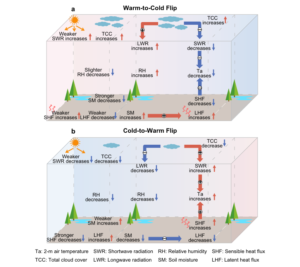Sudden Swings in Temperature Threaten Lives, Crops, and Climate Stability
A new global study has revealed that more than 60% of the world has experienced sudden and extreme temperature shifts known as temperature flips over the past six decades. These rapid transitions from blistering heat to severe cold, or vice versa, leave little room for human or ecological systems to adapt, posing severe risks to health, infrastructure, agriculture, and the environment.

What Are Temperature Flips?
Temperature flips refer to short-term, intense shifts between extreme hot and cold conditions. Unlike isolated heatwaves or cold spells, these flips pack a double punch by swinging between both extremes within a short window. The study, published in Nature Communications found that these climate shocks are becoming more frequent, intense, and faster especially in regions like East Asia, Eastern North America, South America, and parts of Africa and Australia.
A Global Threat Intensifying Over Time
The research analysed global climate data from 1961 to 2023 and found a worrying rise in flip events, especially since the late 20th century. While the tropics and polar regions were relatively stable, mid-latitude regions experienced the most extreme transitions. East Asia and South America saw some of the strongest and fastest shifts.
One major contributor to these events is the behaviour of Rossby waves large atmospheric waves that redistribute heat across the planet. Disruptions in these waves, intensified by global warming, make temperature flips more common and more extreme.
Why Temperature Flips Are Dangerous
Unlike prolonged climate events, temperature flips create a shock effect. A sudden switch from hot to cold (or vice versa) confuses agricultural cycles harms crops, triggers health emergencies, and disrupts energy supply systems. In April 2021, for example, Europe went from an unusually warm period to a sudden cold snap, causing widespread frost damage to vineyards and orchards.
The researchers warn that such shifts pose an increasing threat to densely populated, low-income regions especially in South and Southeast Asia where adaptive infrastructure is weaker and public health systems are more vulnerable.
Projections for the Future
If current greenhouse gas emissions continue unchecked (as under scenarios SSP 5–8.5 and SSP 3–7.0), temperature flips are expected to increase in:
- Frequency by 7–8%
- Intensity by over 7%
- Speed of transition (duration shortening by up to 3.24%)
By the end of the century global population exposure to these events could double. Alarmingly, low-income countries could face exposure levels up to 6.5 times higher than the global average.
In contrast low to medium emission pathways (like SSP1–2.6) show that strong climate action could reduce the rise in flips significantly, offering hope for future generations.
Solutions & Conclusion: A Global Wake-Up Call
Temperature flips are not just another statistic they are an escalating global emergency. Their rise underlines the urgent need for:
- Stronger emission reduction efforts to slow global warming and stabilise the climate system.
- Targeted support for vulnerable nations, especially in Asia, Africa, and South America, to build adaptive infrastructure and early warning systems.
- Investment in resilient agriculture to protect food security from climate shocks.
- Public awareness and preparedness programs to safeguard health and energy systems during abrupt weather changes.
As the climate crisis deepens it’s clear that we must prepare not just for gradual warming but for the sudden, violent flips that can turn our environments from hot to hostile overnight. The future demands both mitigation and adaptation and it demands them now.
